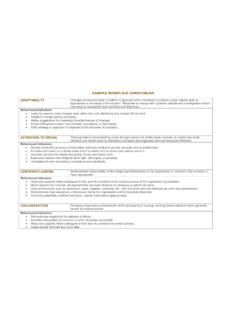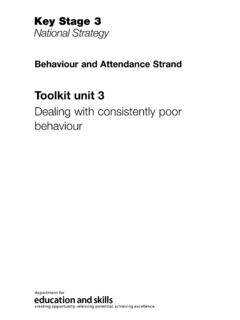Transcription of FAO Advisory Note on Fall Armyworm (FAW) in …
1 FAO Advisory Note on fall Armyworm (FAW) in AfricaADVISORY NOTE5 June 2017 fall Armyworm (Spodoptera frugiperda), FAW, is an insect pest that feeds on more than 80 crop species, causing damage to economically important cultivated cereals such as maize, rice, sorghum, and also to legumes as well as vegetable crops and cotton. It is native to tropical and subtropical regions of the Americas, with the adult moth able to move over 100 km per night. It lays its eggs on plants, from which larvae hatch and begin feeding. High infestations can lead to significant yield loss. Farmers in the Americas have been managing the pest for many years, but at significant cost. Nature of the threat and its spread in africa FAW was first detected in Central and Western africa in early 2016 (Sao Tome and Principe, Nigeria, Benin and Togo) and in late 2016 and 2017 in Angola, Botswana, Burundi, Democratic Republic of Congo, Ethiopia, Ghana, Kenya, Malawi, Mozambique, Namibia, Niger, Rwanda, Sierra Leone, South africa , Tanzania, Uganda, Zambia, and Zimbabwe, and it is expected to move further.
2 Although it is too early to know the long-term impact of FAW on agricultural production and food security in africa , it has the potential to cause serious damage and yield losses. FAW s presence in africa is irreversible. Large-scale eradication e orts are neither appropriate nor feasible. Gathering and analyzing experiences and best practices from the Americas will help design and test a sustainable FAW management program for smallholders in immediate response to FAWFAO took immediate actions to support countries in responding to the threat of FAW in africa . BACKGROUNDA consultative meeting was held in Harare, Zimbabwe (14-16 February 2017) with government o cials and stakeholders from Southern africa to provide an update on the current situation, and support emergency preparedness and rapid pest management response. FAO undertook a series of quick actions such as the development and sharing with countries of a technical guide for FAW identification, protocols to assess levels of infestation and damage, and recommendations for management options including support to governments in the development of action further meetings on FAW, one for the SADC region as follow-up to the Harare consultative meeting and a second one (All africa ) jointly organized by FAO, AGRA and CIMMYT, were held in Nairobi (25-28 April 2017).
3 The All africa meeting gathered partners from governments, national, regional and international research and development institutions, academia and donor agencies as well as representatives from the private sector. The meeting came up with a set of action points and recommendations addressing research gaps, need for more knowledge on the pest s behavioural and biological adjustments to African ecological context, monitoring, early warning and forecasting, contingency planning, impact assessment, short-, medium- and long-term measures for management of the pest. The meeting participants also agreed that FAO should take a lead coordination role in FAW response in africa . FAO support to governments and farmers to manage FAWFAO recommends and is taking leadership in helping member countries, farmers organizations, and individual farmers to sustainably manage FAW through:Short-term measuresIn the short term, FAO through South-South Cooperation will bring the expertise and knowledge gained from relevant sources and adapt them to africa .
4 From this knowledge, recommended components of a sustainable management program for farmers will be designed. Special attention will be paid to recommendations on targeted pesticide use and the use of biological recommendations will be tested and adapted to local conditions across africa via the Farmers Field Schools that FAO has supported: farmers and communities will carry out adaptive research to refine sustainable pest management and educational material in local languages will be produced and distributed, along with key messages for local radio Integrated Pest Management (IPM) programmes using an agro-ecosystems approach and using Farmer Field Schools will be Annex A on pesticide useMedium-term measuresIn the medium-term, FAO will support African countries understanding and knowledge on how to sustainably manage FAW, based on area-wide monitoring, consolidated knowledge on the developing patterns and ecology of FAW in africa as well as reliable data on yield losses and socio-economic impact.
5 FAO to support African countries in designing appropriate pest management approaches on the FAW. Deepen South-South cooperation to fully integrate experience from the Americas in the long-term management of FAW in africa . There are many farmers, researchers and extension workers who have large experience in managing FAW in the Americas. See Annex B on Genetically Modified Organisms (GMOs)Long-term measures (incorporating relevant research results)Development of long-term solutions must be based on using a truly agro-ecosystems approach to FAW management based on the experience from the Americas and integrating relevant research results. Develop sustainable farming systems using IPM and innovative technologies with an emphasis on preventive measures and particular focus on agronomic practices, use of adapted and tested tolerant/resistant varieties, comprehensive biological control programmes which combines importation and release of proven beneficial organisms from the Americas (provided pre-release investigations are successfully completed) and enhancing indigenous natural enemies, combined with innovative pest surveillance and forecasting Advisory Note on fall Armyworm PAGE 1 Photo: FAOFall Armyworm (Spodoptera frugiperda), FAW, is an insect pest that feeds on more than 80 crop species, causing damage to economically important cultivated cereals such as maize, rice, sorghum, and also to legumes as well as vegetable crops and cotton.
6 It is native to tropical and subtropical regions of the Americas, with the adult moth able to move over 100 km per night. It lays its eggs on plants, from which larvae hatch and begin feeding. High infestations can lead to significant yield loss. Farmers in the Americas have been managing the pest for many years, but at significant cost. Nature of the threat and its spread in africa FAW was first detected in Central and Western africa in early 2016 (Sao Tome and Principe, Nigeria, Benin and Togo) and in late 2016 and 2017 in Angola, Botswana, Burundi, Democratic Republic of Congo, Ethiopia, Ghana, Kenya, Malawi, Mozambique, Namibia, Niger, Rwanda, Sierra Leone, South africa , Tanzania, Uganda, Zambia, and Zimbabwe, and it is expected to move further. Although it is too early to know the long-term impact of FAW on agricultural production and food security in africa , it has the potential to cause serious damage and yield losses. FAW s presence in africa is irreversible.
7 Large-scale eradication e orts are neither appropriate nor feasible. Gathering and analyzing experiences and best practices from the Americas will help design and test a sustainable FAW management program for smallholders in immediate response to FAWFAO took immediate actions to support countries in responding to the threat of FAW in africa . A consultative meeting was held in Harare, Zimbabwe (14-16 February 2017) with government o cials and stakeholders from Southern africa to provide an update on the current situation, and support emergency preparedness and rapid pest management response. FAO undertook a series of quick actions such as the development and sharing with countries of a technical guide for FAW identification, protocols to assess levels of infestation and damage, and recommendations for management options including support to governments in the development of action further meetings on FAW, one for the SADC region as follow-up to the Harare consultative meeting and a second one (All africa ) jointly organized by FAO, AGRA and CIMMYT, were held in Nairobi (25-28 April 2017).
8 The All africa meeting gathered partners from governments, national, regional and international research and development institutions, academia and donor agencies as well as representatives from the private sector. The meeting came up with a set of action points and recommendations addressing research gaps, need for more knowledge on the pest s behavioural and biological adjustments to African ecological context, monitoring, early warning and forecasting, contingency planning, impact assessment, short-, medium- and long-term measures for management of the pest. The meeting participants also agreed that FAO should take a lead coordination role in FAW response in africa . FAO support to governments and farmers to manage FAWFAO recommends and is taking leadership in helping member countries, farmers organizations, and individual farmers to sustainably manage FAW through:Short-term measuresIn the short term, FAO through South-South Cooperation will bring the expertise and knowledge gained from relevant sources and adapt them to africa .
9 From this knowledge, recommended components of a sustainable management program for farmers will be designed. Special attention will be paid to recommendations on targeted pesticide use and the use of biological recommendations will be tested and adapted to local conditions across africa via the Farmers Field Schools that FAO has supported: farmers and communities will carry out adaptive research to refine sustainable pest management and educational material in local languages will be produced and distributed, along with key messages for local radio Integrated Pest Management (IPM) programmes using an agro-ecosystems approach and using Farmer Field Schools will be Annex A on pesticide useMedium-term measuresIn the medium-term, FAO will support African countries understanding and knowledge on how to sustainably manage FAW, based on area-wide monitoring, consolidated knowledge on the developing patterns and ecology of FAW in africa as well as reliable data on yield losses and socio-economic impact.
10 FAO to support African countries in designing appropriate pest management approaches on the FAW. Deepen South-South cooperation to fully integrate experience from the Americas in the long-term management of FAW in africa . There are many farmers, researchers and extension workers who have large experience in managing FAW in the Americas. See Annex B on Genetically Modified Organisms (GMOs)Long-term measures (incorporating relevant research results)Development of long-term solutions must be based on using a truly agro-ecosystems approach to FAW management based on the experience from the Americas and integrating relevant research results. Develop sustainable farming systems using IPM and innovative technologies with an emphasis on preventive measures and particular focus on agronomic practices, use of adapted and tested tolerant/resistant varieties, comprehensive biological control programmes which combines importation and release of proven beneficial organisms from the Americas (provided pre-release investigations are successfully completed) and enhancing indigenous natural enemies, combined with innovative pest surveillance and forecasting Advisory Note on fall Armyworm PAGE 2 Photo: FAO/Lechoko NokoFALL Armyworm Q & A Q1: What is fall Armyworm (FAW)?
















